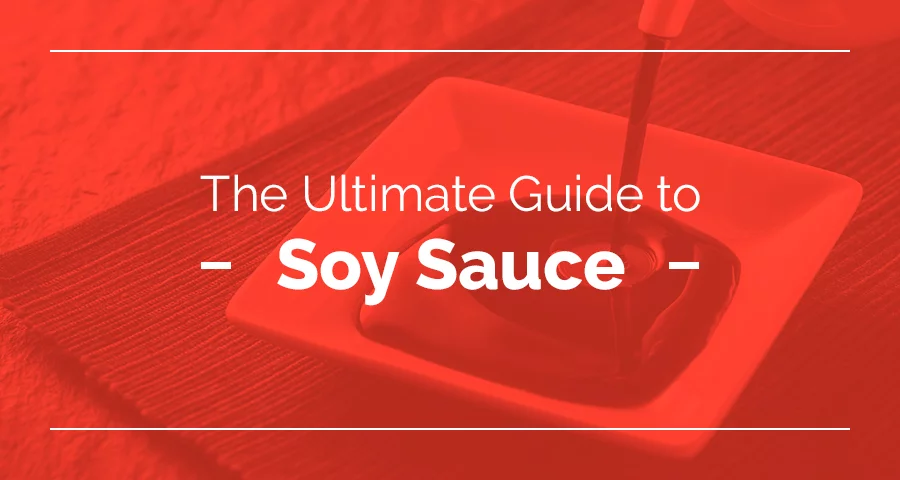Most people picture soy sauce as one simple condiment for dipping sushi. However, many types of sauces are soy-based and widely used in Asian-style cooking. Variations of soy sauce are used throughout Asia, and each one contributes a slightly different taste, color and consistency to a dish depending on which type you use.
From aminos to tahini, you see lots of soy sauce-related terms tossed around online and feel overwhelmed by the sheer amount of soy-based sauces and alternative options available nowadays. And although each one of these Asian soy-centered sauces offers its own unique flavor, Tamari sales have surged in recent years as many began to turn to it as a gluten-free soy sauce. But as you see the word “Tamari” popping up more and more among your favorite recipe blogs, you may be left wondering: What is Tamari sauce used for?
No need to despair — we have compiled an ultimate guide to soy sauce to clear up any confusion and help you navigate the grocery aisles with ease the next time you’re cooking stir-fry. This extensive collection of soy sauce information will walk you through the different versions of soy sauce by exploring how each kind is made and what it has to offer in regard to taste and texture. We’ll also cover the potential dietary benefits, how each sauce is most commonly used, differences in cost and how you can best incorporate the sauce into your cooking.
Types of Soy Sauce
There are several main types of soy sauce to be aware of:
Tamari: A type of soy sauce made from fermented soybeans, with no or minimal wheat content. Tamari has a richer, more complex flavor compared to regular soy sauce.
Shoyu: The most common type of soy sauce, originating from China. Shoyu is brewed from a mixture of soybeans, wheat, and other grains.
Dark Soy Sauce: A thicker, darker soy sauce that is aged longer. It has a more robust, slightly sweet flavor.
Light Soy Sauce: A thinner, lighter colored soy sauce that is saltier and more delicate in flavor.
Shiro (White) Soy Sauce: The lightest variety, made mostly from wheat rather than soybeans.
To keep this handy soy sauce manual as streamlined as possible, Tamari will serve as our baseline for comparing other types of soy sauce.
Table of Contents
What Is Tamari Soy Sauce Used For?
Tamari vs. Soy Sauce
Tamari vs. Aminos
Tamari vs. Tahini
Tamari vs. Tamarind
Make SAN-J Tamari Your Go-To Soy Sauce
What Is Tamari?
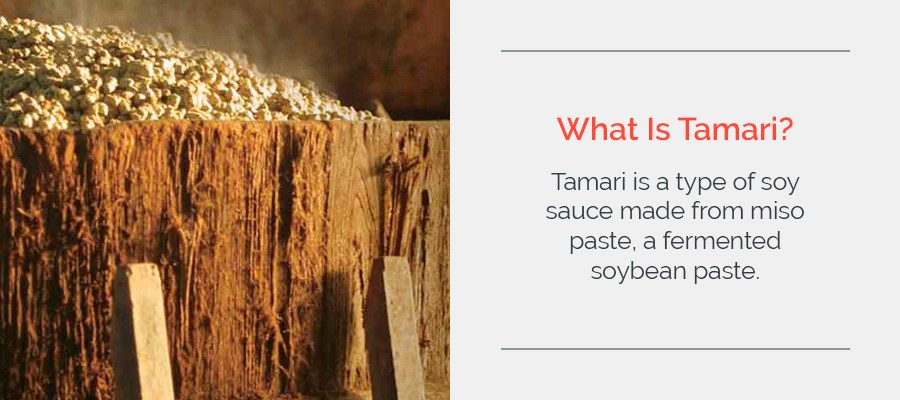
Tamari is a type of soy sauce made from miso paste, a fermented soybean paste. Dating all the way back to the seventh century, the protein-rich liquid that accumulates as miso ripens was labeled Tamari, meaning “that which accumulates,” and quickly became known for its tasty cooking properties.
The process of making Tamari soy sauce, known as “brewing,” involves pressing the liquid that flows from miso paste as it ages, which could take up to six months. Unlike most other variations of soy sauce, no other ingredients go into producing Tamari, making it a 100% soy-based sauce.
What Is Tamari Soy Sauce Used For?
Before diving into what each type of soy sauce brings to the table, we have to get comfortable with our standard of measurement — Tamari. In this section, we’ll find out what kinds of recipes Tamari is used for and why it’s such a good all-purpose soy sauce to keep in your cupboard. But first, we must understand exactly what Tamari is and explore its taste profile as well as the potential benefits of using the sauce.
What Does Tamari Taste Like?
Because it is brewed differently from any other kind of soy sauce, Tamari has a distinct taste that is mellow and slightly more nuanced than other soy sauces. Tamari’s central characteristic is umami, the fifth and least known foundational flavor. Umami is the savory, rich flavor most commonly associated with the “mouthwatering” flavor found in beef, cooked mushrooms and aged cheeses. Because of its unique but subtle taste, umami is frequently used to give vegetarian and vegan dishes a “meaty” flavor.
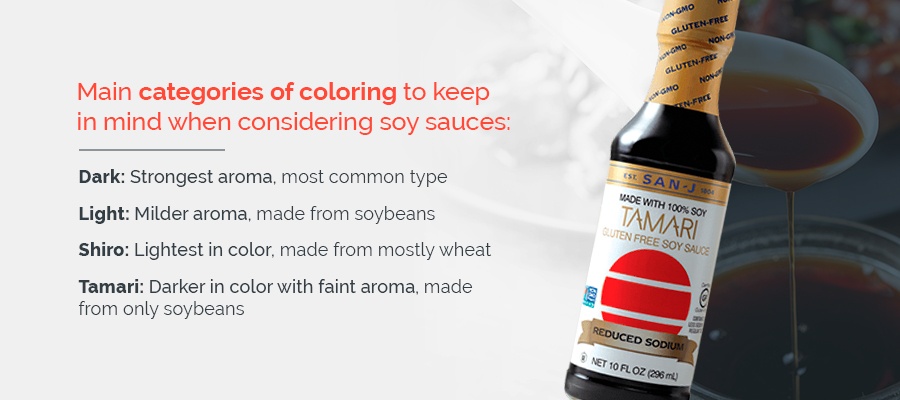
What Does Tamari Look Like?
Some soy sauces are lighter or darker than others, which indicate their flavoring. Here are the main categories of coloring to keep in mind when considering soy sauces:
- Dark: Strongest aroma, most common type
- Light: Milder aroma, made from more soybeans than wheat
- Shiro: Lightest in color, made from mostly wheat
- Tamari: Darker in color with faint aroma, made from only soybeans
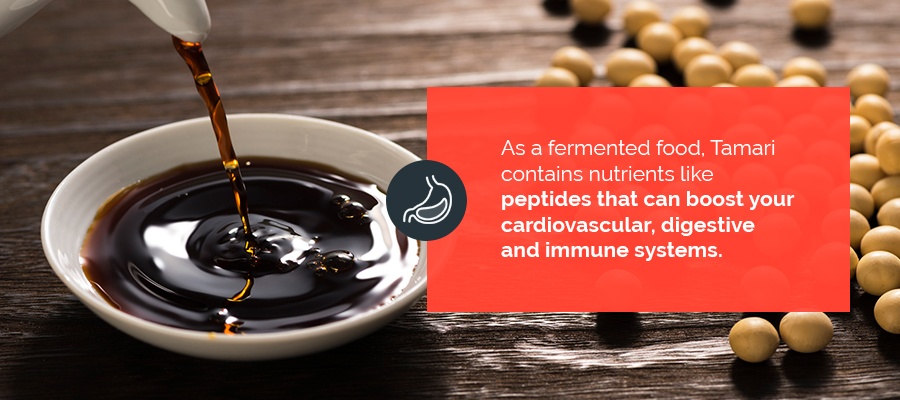
Why Use Tamari?
Tamari offers a wide range of vitamins and minerals, including manganese and iron, as well as antioxidant phenolic acids and protein. As a fermented food, Tamari contains nutrients like peptides that can boost your cardiovascular, digestive and immune systems. These health benefits combined with Tamari’s umami flavor make it a deliciously nutritious way to work more plant-based protein into your diet.
Additionally, as we just learned above, Tamari is made purely from soy. This means that Tamari soy sauce does not contain any gluten, making the condiment extra appealing to those who must adhere to a gluten-free diet. Even though Tamari is typically gluten-free, make sure you always double-check the label to ensure you are completely avoiding gluten.
SAN-J Tamari Soy Sauce is certified gluten-free by the Gluten-Free Certification Organization and non-GMO verified by the Non-GMO Project.
How to Use Tamari
Now that you understand the what and why behind Tamari soy sauce, it’s time to find out how you can use Tamari. Both Tamari’s flavor and consistency lend themselves to supporting other flavors to help them stand out more. Essentially, Tamari is the unsung hero working hard behind the scenes to enhance a dish’s main spotlight ingredients. Tamari never truly gets the recognition it deserves but without it, many dishes would go from stellar to mediocre.
Tamari soy sauce can truly be used in just about any recipe to substitute for salt or bring out the dish’s other flavors. Not limited to a single style of cooking, Tamari’s savory umami flavor does wonders to underscore the tastes in recipes from all over the world.
More specifically, you can use Tamari whenever you would typically use Chinese soy sauce — in everything from dips, dressings and marinades to stir-fries, soups and stews. Don’t be afraid to get creative with your Tamari use and do something outside the box like season roasted nuts with the sauce for either topping salads or future snacking. If you need some culinary inspiration, here are some of our favorite Tamari recipes to get your creative juices flowing:
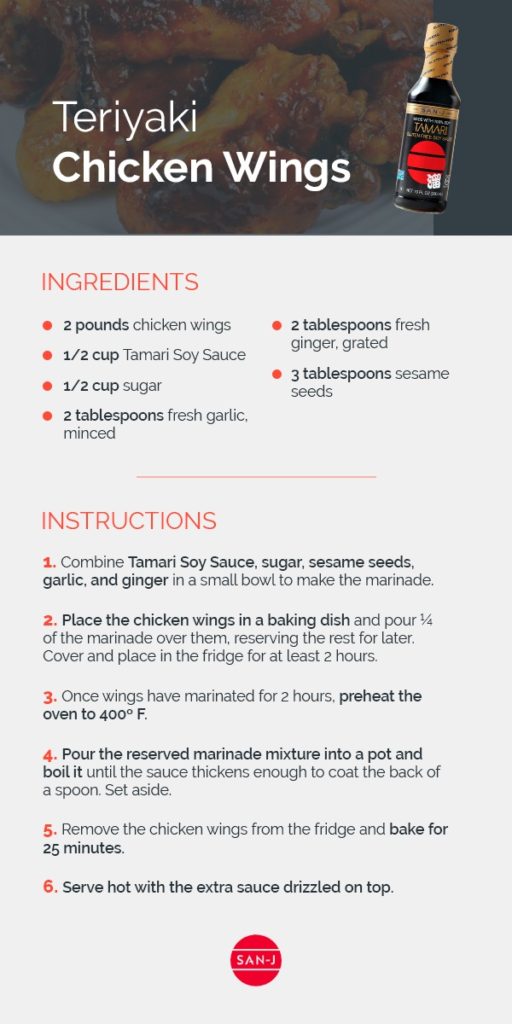
- Teriyaki Chicken Wings
- Japanese Soba Noodle Soup (Kake Soba)
- Creamy Tamari Sesame Dressing
- Karaage (Japanese Fried Chicken)
- Slow Cooker Asian Pulled Pork with Pickled Vegetables in Lettuce Cups
- Tamari Ice Cream with Toasted Pecan Marshmallows
Don’t forget, Tamari’s balanced flavor and smooth consistency make it perfect as a dipping sauce all on its own. Many people prefer Tamari to Chinese soy sauce with their sushi because Tamari’s less salty flavor complements the fish, rather than overwhelming the dish with salt. Use as a condiment straight up with noodles, dumplings, tofu, fish and more.
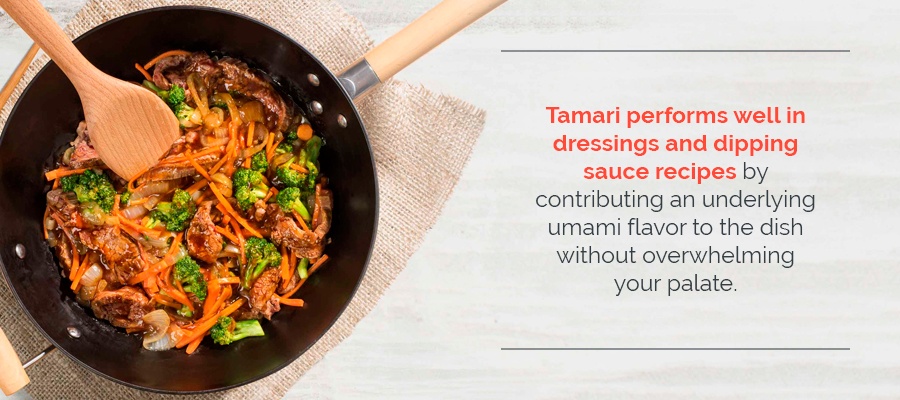
Tamari vs. Soy Sauce
The main difference between tamari and regular soy sauce is that tamari is brewed solely from fermented soybeans, while soy sauce contains a mixture of soybeans and wheat. In fact, up to 50% of soy sauce’s total makeup can be wheat. This also means that regular soy sauce is not gluten-free, whereas Tamari is.
Tamari also tends to have a richer, more complex umami flavor compared to the sharper, saltier taste of soy sauce. It’s less likely to contain additives as well. Soy sauce is generally thinner and saltier, while tamari has a thicker, darker consistency.
The sauces’ difference in brewing methods also gives Tamari 37% more soy protein than Chinese soy sauce. Because Tamari soy sauce has more soy protein to get broken into complex amino acids during its fermentation process, it ends up being slightly richer in protein and taste than regular soy sauce.
In general, Tamari is less likely to contain additives than regular soy sauce, which often includes preservatives like sodium benzoate on its ingredients list. Tamari’s shorter ingredient list — water, soybeans and salt — lends itself to the sauce’s thicker consistency, darker color and richer flavor when compared with Chinese soy sauce.
Tamari’s less salty composition makes it great to cook with when you don’t want an overpowering taste to disrupt the harmony of your dish and steal the attention away from the recipe’s main flavors. Specifically, Tamari performs well in dressings and dipping sauce recipes by contributing an underlying umami flavor to the dish without overwhelming your palate. An added bonus of Tamari is that its flavor doesn’t flash off under high temperatures like regular soy sauce does due to its higher alcohol and esters content, which makes its flavor fizzle under high temperatures.
While Tamari should be used for any Japanese cooking, Chinese soy sauce, of course, goes best with traditional Chinese recipes. Chinese soy sauce also functions well in stir-fries when a more powerful boost of salt is needed to season otherwise dull rice or vegetables.
Despite these distinct differences, Tamari and Chinese soy sauce are quite similar and can easily substitute for each other in recipes if you don’t have one or the other on hand. You might notice a slight change in flavor, but the substitution will by no means ruin the dish.
If you are in the market for soy sauce, keep in mind that Tamari soy sauce is usually priced slightly higher than Chinese soy sauce because it is made from only soybeans, which are more expensive than wheat.
Shoyu vs. Tamari
The main difference between shoyu and tamari is the ratio of soybeans to wheat. Shoyu contains a higher proportion of wheat, while tamari is made from soybeans.
This results in shoyu having a lighter, more delicate flavor, while tamari is richer and more concentrated. Tamari also tends to be darker in color. Both can be used interchangeably in many recipes, but the subtle flavor differences are worth noting
Tamari vs. Dark Soy Sauce
The key differences between tamari and dark soy sauce lie in their composition, flavor profiles, and nutritional content. Tamari is brewed solely from fermented soybeans, while dark soy sauce contains a blend of soybeans and wheat.
This results in tamari having a more complex, nuanced umami flavor, compared to the saltier and slightly sweeter taste of dark soy sauce. Tamari is also naturally gluten-free, while dark soy sauce may contain wheat. Additionally, tamari is thicker and less salty than dark soy sauce. Both work well in marinades, stir-fries, and dipping sauces, but the distinct flavor profiles are worth noting. Tamari is a better choice for those avoiding gluten.
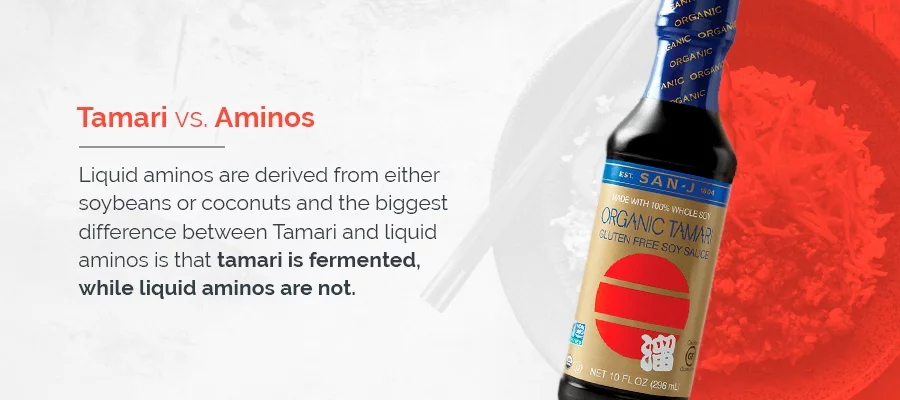
Tamari vs. Aminos
Liquid aminos are a common soy sauce substitute for those who are on a gluten-free diet. As the name suggests, liquid aminos are concentrated amino acids derived from either soybeans or coconuts. The biggest difference between Tamari and liquid aminos is that tamari is fermented, while liquid aminos are not.
Because amino acids are the building blocks of protein, which is essential to the human diet, liquid aminos boast many health perks, especially to anyone sticking to a plant-based diet. But because liquid aminos do not go through fermentation, they do not offer the same digestive and gut health benefits that Tamari does.
However, the option of liquid aminos produced simply from coconut tree sap and salt makes the condiment a good alternative for anyone trying to avoid soy for health reasons. As a grain-free sauce, coconut liquid aminos are a popular choice for those in the paleo community as well.
In regard to taste, Tamari and aminos are extremely similar, with each of the condiments presenting a strong, savory umami flavor. Overall, the taste of liquid aminos is somewhat muted in comparison with Tamari, which offers a fuller flavor. The coconut version of liquid aminos, in particular, is more mild, far less salty and even slightly sweet.
Although liquid aminos are not quite as bold or bursting with flavor as Tamari, they still share its dark color and “meaty” flavor, making it both a great substitute for traditional Chinese soy sauce and a valuable ingredient to keep in the pantry for anyone who follows a vegan, vegetarian, gluten-free or paleo diet. Because liquid aminos are essentially interchangeable with both Tamari and regular soy sauce, you can use it in stir-fries, on veggies or on its own as a condiment.
When shopping for liquid aminos, be aware that you may have to go to a health store to find them and they are typically more expensive than Tamari or regular soy sauce.
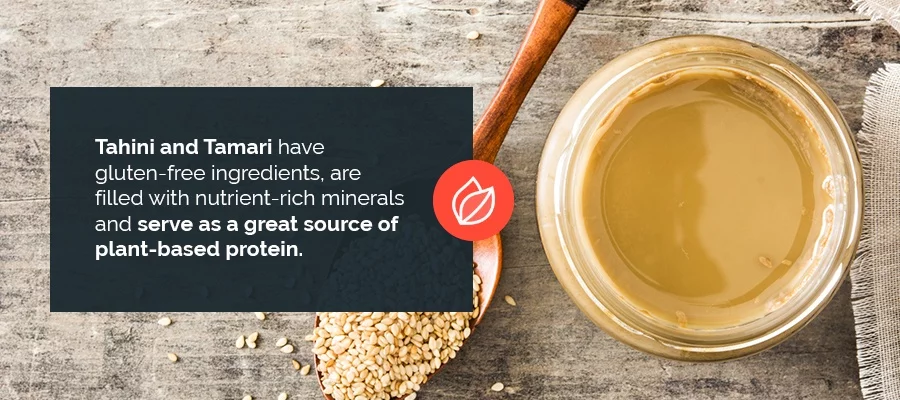
Soy Sauce vs. Liquid Aminos
Liquid aminos are a popular soy sauce alternative, made by extracting amino acids from soybeans or coconuts. Unlike soy sauce, liquid aminos are not fermented, so they don’t have the same depth of flavor. However, they are a good gluten-free option.
Liquid aminos have a more muted, slightly sweet taste compared to the bold umami of soy sauce. They can be used as a 1:1 substitute, but the flavor profile will be a bit different.
Tamari vs. Tahini
Tamari and tahini have many more differences than they do similarities. Whereas Tamari comes completely from soybeans, tahini is made purely from sesame seeds. Unlike Tamari, tahini involves no fermentation. Instead, it is produced by grinding sesame seeds into a spreadable paste.
As an oily paste, the texture of tahini is closer to that of a nut butter, whereas Tamari’s sauce-like qualities give it a much thinner consistency. Along with texture, the tastes of Tamari and tahini vary as well. As opposed to Tamari’s umami flavor, tahini has an earthy bitterness from the ground sesame seeds.
Tahini is popular in Middle Eastern and Greek cuisine, while Tamari is a Japanese staple. So although both are used as key dip ingredients, tahini most often appears in thicker dips, such as hummus, rather than thinner sauces as Tamari does. Being a heavier substance than Tamari, tahini offers a different variety of health benefits, such as healthy fats and anti-inflammatory compounds.
After this long list of differences, it may seem like Tamari and tahini would never get along. But opposites attract in this case, and mixing tahini with Tamari in various dipping sauce recipes produces a delicious result! For example, replacing the peanut butter with tahini and Chinese soy sauce with Tamari in your traditional spring roll sauce recipe provides a refreshing twist on a classic.
In the health world, tahini and Tamari find more common ground. Both have gluten-free ingredients, are filled with nutrient-rich minerals and serve as a great source of plant-based protein. These characteristics make Tamari and tahini great additions to vegan, vegetarian and gluten-free grocery lists.
Because tahini and Tamari are vastly different products, it is difficult to compare their prices. If you are interested in trying tahini in your next recipe and looking to save some money, you can easily make your own batch of tahini by buying sesame seeds, toasting them to bring out their nutty flavor and then blending them in your food processor along with some oil and a pinch of salt.
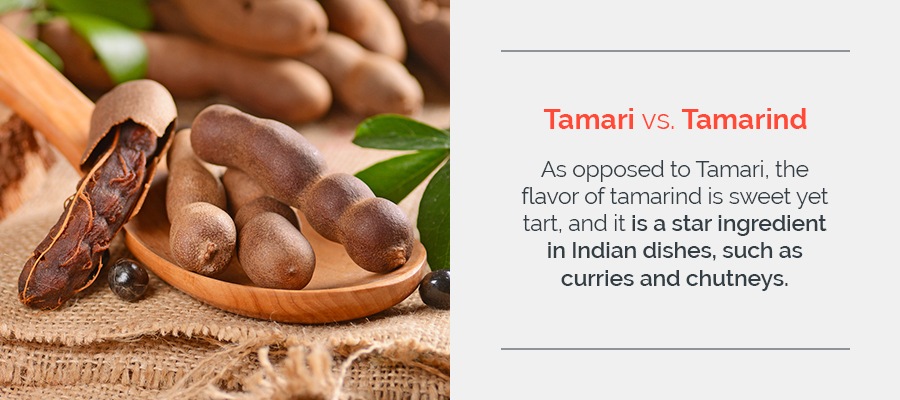
Tamari vs. Tamarind
Despite their similarly spelled names, Tamari and tamarind are nothing alike. As opposed to Tamari’s Japanese roots, tamarind is a product of the pulpy seed pod plucked from an evergreen tree originally from eastern Africa.
Coming from opposite sides of the globe, tamarind and Tamari’s differences don’t stop there. The flavor of tamarind is sweet yet tart, and it is a star ingredient in Indian dishes, such as curries and chutneys. In Pacific Rim countries and the tropics, tamarind is used interchangeably with lemon juice — a much different substitute than that of Chinese soy sauce.
Whereas Tamari is sold in a bottle as a liquid, you will find tamarind offered in many different forms. The concentration of tamarind is contingent on what form you purchase it in, with most recipes calling for a paste or liquid substance to serve as a citrus juice-like component.
Tamarind powder and seedless tamarind concentrate paste come in jars, while dried “bricks” of tamarind are small, pressed flats of the seed pod’s pulp, and give you the option of seeds or seedless. Depending on where you’re shopping, you may even be able to purchase the seed pods fresh and unprocessed.
Yet another difference between Tamari and tamarind is tamarind’s lack of fermentation. Because tamarind is a spice, it is merely picked from its tree and sold without going through any changes to its chemical makeup regardless of how concentrated its form.
Once again, an array of differences makes it hard to do a direct price comparison between tamarind and Tamari. Bear in mind that the price of tamarind may vary depending on what form you buy it in and how much extra effort you have to put in to achieve a workable, diluted substance.
In summary, tamarind is absolutely nothing like Tamari and the two are only ever confused for each other because of their similar names. Now that you know more about them and their differences, you will never get them mixed up at the supermarket.
Make SAN-J Tamari Your Go-To Soy Sauce
If you’re looking for a flavorful gluten-free soy sauce option to elevate your cooking, look no further than SAN-J Tamari Soy Sauce. Our Tamari soy sauce is brewed with 100% soybeans and no wheat. This method of brewing results in a higher concentration of soy protein, which produces a markedly richer and smoother taste than regular soy sauce.
We offer a wide range of Tamari Soy Sauce products, including organic and reduced-sodium — all made without additives or artificial preservatives. Verified by both the Gluten-Free Certification Organization and Non-GMO Project, SAN-J Tamari Soy Sauce qualifies as a certified gluten-free, non-GMO, kosher and vegan product, so you can feel good about adding it to your dishes and serving it to your family.
Now that you’ve read up on your soy sauce varieties and recognize the benefits of Tamari, use our product locator to help you find the SAN-J Tamari Soy Sauce closest to you or you can also buy our products online. With a precise brewing method that’s been passed down for over 200 years through eight generations, SAN-J Tamari Soy Sauce is a tried and true family favorite.
And once you’ve mastered incorporating the flavors of SAN-J’s Tamari into your day to day cooking practices, check out SAN-J’s other gluten-free products, including Asian cooking sauces, soups and brown rice crackers, to stay on the cutting edge of cooking.
Back to Top

